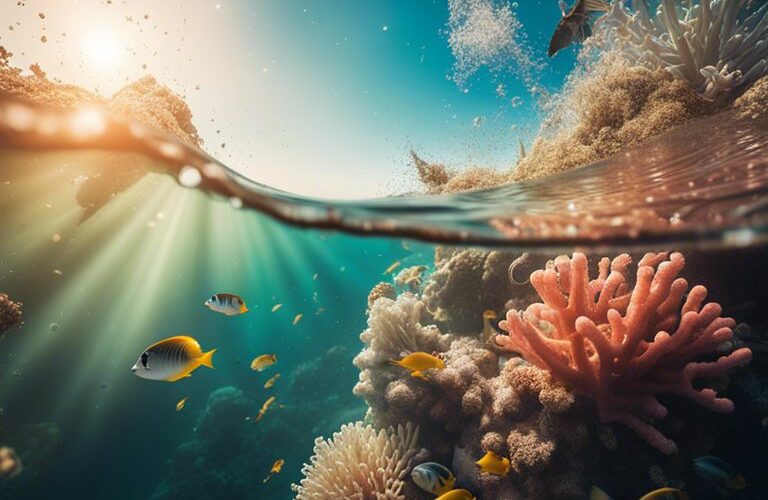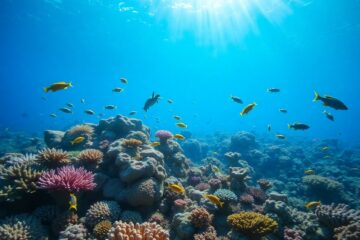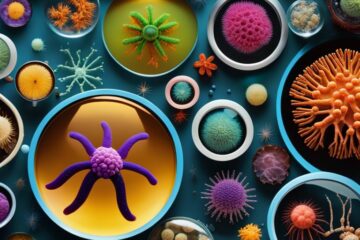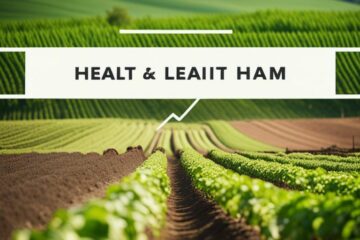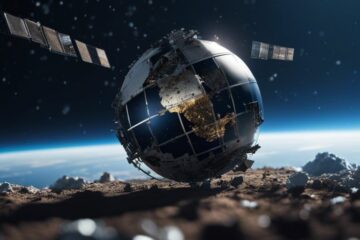Microplastics, minuscule pieces of plastic less than five millimeters in size, are becoming a pervasive issue in our oceans with devastating consequences. While these tiny particles may seem harmless due to their size, the hidden dangers they pose to marine life and human health are immense. As these plastic pieces infiltrate every corner of our oceans, they threaten not only the creatures that inhabit these waters but also the overall health of our planet.
Table of Contents
The Origin of Microplastics
Microplastics are minuscule pieces of plastic, measuring less than five millimeters in size, that pose a significant threat to our marine ecosystems. These tiny particles are often the result of larger plastic items breaking down over time due to various factors such as sunlight, wave action, and wind. Additionally, microplastics can come from a variety of sources, each contributing to the growing crisis in our oceans.
Sources of Microplastics
Microplastics can originate from a range of sources, including the breakdown of larger plastic debris like bottles, bags, and fishing nets. These items can fragment into smaller pieces through mechanical action, such as the grinding against rocks or sand, or through biological processes as they are colonized by marine organisms. Other sources include microbeads from personal care products, synthetic fibers from clothing, and industrial resin pellets known as nurdles.
Pathways into the Marine Environment
Microplastics find their way into the marine environment through various pathways. One common route is through urban runoff and sewage systems, which carry microplastics from inland areas to the coast. Additionally, improper waste management and littering contribute to the direct entry of microplastics into rivers and oceans. Marine activities like shipping and fishing also play a role in introducing microplastics into the marine environment through the release of plastic waste and gear.
Sources of microplastics in the marine environment are diverse and widespread, making it challenging to pinpoint a single solution to this complex issue. It is crucial for individuals, industries, and governments to work together to reduce the production and release of plastic into the environment, ultimately stemming the flow of microplastics into our oceans.
Microplastics in the Food Chain
Obviously, one of the major concerns of microplastics in our oceans is how they enter the food chain and impact marine life and human health. These tiny plastic particles are often mistaken for food by marine animals, leading to a chain reaction of harmful effects.
Ingestion by Marine Life
Any marine organism that mistakes microplastics for food faces a multitude of risks. Once ingested, these particles can cause internal damage, blockages, and even lead to starvation. Additionally, microplastics have the ability to adsorb toxic chemicals, which can concentrate in the tissues of the animals that consume them, posing a threat to their overall health and survival.
Furthermore, as smaller marine organisms are consumed by larger ones, the concentration of microplastics increases up the food chain, eventually reaching seafood consumed by humans. This bioaccumulation of microplastics raises significant concerns about the potential impacts on human health.
Impact on Human Health
With the growing evidence of microplastics in seafood, the impact on human health is a pressing concern. Studies have shown that ingestion of microplastics can lead to inflammatory responses, oxidative stress, and even cellular damage in the human body. Additionally, the presence of microplastics in seafood raises concerns about the ingestion of harmful chemicals that may have adsorbed onto these particles.
Environmental Impact of Microplastics
Despite their small size, microplastics have a significant environmental impact on our oceans. These tiny pieces of plastic, less than 5mm in size, are causing widespread ecological damage and posing a serious threat to marine life.
Ecological Consequences for Marine Habitats
The presence of microplastics in marine habitats has far-reaching consequences. They can accumulate in sediments, affecting the oxygen levels and nutrient cycles in the ecosystem. This can disrupt the balance of marine habitats and lead to a decline in biodiversity.
The ingestion of microplastics by marine organisms can also have detrimental effects on their health. Plastic particles can block digestive systems, causing starvation and even death. In addition, the chemicals in microplastics can be toxic, leading to physiological and behavioral changes in marine species.
Long-Term Impacts on Biodiversity
Biodiversity in our oceans is facing a major threat from the proliferation of microplastics. As these tiny plastic particles persist in the environment, they continue to accumulate in marine organisms, disrupting the food chain and affecting species at all levels. This can lead to a decrease in biodiversity and imbalances in marine ecosystems.
Microplastics also have the potential to spread harmful pathogens and invasive species across marine habitats. This can further disrupt the delicate balance of ecosystems and lead to the decline of certain species, affecting the overall biodiversity of our oceans.
Microplastics pose a long-term threat to biodiversity in our oceans, with far-reaching consequences for marine life. It is crucial that we address this issue to protect the delicate balance of our marine ecosystems and ensure the health and sustainability of our oceans for future generations.
Chemical Hazards of Microplastics
Your everyday plastic items, such as bottles, bags, and packaging, are not just composed of plastic polymers but also contain a variety of additives to give them desired properties. When these items break down into microplastics, these additives become a hidden danger in our oceans. Additionally, microplastics have the ability to absorb pollutants from the surrounding water, concentrating toxic chemicals on their surfaces.
Additives and Pollutant Absorption
To compound the issue, these absorbed pollutants can leach out into the tissues of marine organisms that mistakenly ingest them, leading to bioaccumulation of toxic substances up the food chain. This poses a serious threat to the health of marine life and even to human consumers of seafood.
Furthermore, some of these additives have endocrine-disrupting properties, which can interfere with the hormonal systems of marine organisms. This disruption can lead to reproductive issues, immune system dysfunction, and other detrimental effects on the health and survival of marine species.
Consequences of Chemical Exposure
To address the consequences of chemical exposure from microplastics, it is crucial to implement regulations that restrict the use of harmful additives in plastic products. Additionally, proper waste management strategies and recycling practices can help reduce the amount of plastic entering our oceans and prevent the further spread of chemical hazards.
Plus, raising awareness about the dangers of microplastics and their associated chemical hazards is essential in encouraging individuals, industries, and governments to take action in combating this widespread environmental issue. By working together to address the chemical hazards of microplastics, we can protect our oceans and preserve the health of marine ecosystems for future generations.
Socioeconomic Implications
Now, let’s delve into the socioeconomic implications of microplastic pollution in our oceans. These tiny plastic particles are causing significant harm to various sectors that rely on the health of marine ecosystems.
Impact on Fisheries and Tourism
Implications of microplastic pollution on fisheries are staggering. The ingestion of microplastics by marine species can lead to bioaccumulation in the food chain, potentially impacting seafood safety and human health. Additionally, the presence of microplastics in fish habitats can disrupt ecosystems, affecting fish populations and the livelihoods of fishing communities.
The tourism industry, which often relies on pristine ocean environments, is also at risk. Microplastic pollution can degrade beaches and coastal areas, deterring tourists and reducing revenue for local businesses. The sight of littered shores and contaminated waters can drive away visitors, impacting economies that depend on tourism.
Economic Cost of Microplastic Pollution
With microplastic pollution infiltrating our oceans at an alarming rate, there are significant economic costs involved. Clean-up efforts to remove microplastics from beaches and coastal waters can be expensive, straining local governments and environmental organizations. Moreover, the decline in seafood stocks due to microplastic contamination can lead to financial losses for fishing industries.
Pollution from microplastics not only harms marine life but also threatens the economic stability of communities that rely on fisheries and tourism. It is imperative for policymakers and industries to address this issue to safeguard both the environment and the economies that depend on healthy oceans.
Global Responses and Strategies
International Policy and Legislation
Unlike some environmental issues that are confined to individual countries, microplastic pollution is a global problem that requires coordinated efforts on an international scale. Strategies to address this issue have been implemented through various international agreements and policies aimed at reducing plastic waste and its impact on marine ecosystems. Organizations like the United Nations Environment Programme (UNEP) have been instrumental in advocating for the regulation of plastic production and consumption to tackle the issue of microplastic pollution.
Efforts such as the Stockholm Convention on Persistent Organic Pollutants and the Basel Convention on the Control of Transboundary Movements of Hazardous Wastes have set guidelines and regulations to limit the production and disposal of plastic waste. These international agreements serve as crucial tools in the fight against microplastic pollution, emphasizing the importance of cooperation and shared responsibility among nations to protect our oceans and marine life.
Innovations in Cleanup and Prevention
With the increasing awareness of the dangers posed by microplastics, innovative technologies and strategies have been developed to clean up and prevent further pollution. These initiatives range from advanced filtration systems in wastewater treatment plants to the development of biodegradable alternatives to conventional plastics. Asia-Pacific Economic Cooperation (APEC) is one example of a regional cooperation platform that has endorsed the development of innovative solutions to address plastic pollution, including microplastics.
Furthermore, collaborations between governments, non-profit organizations, and the private sector have led to the implementation of cleanup initiatives such as beach clean-ups, ocean patrols, and the deployment of cleanup vessels equipped with specialized technology to collect microplastics from the ocean surface. These efforts mark a significant step towards mitigating the impact of microplastics on marine environments and paving the way for a cleaner, healthier ocean for future generations.
Summing up
Considering all points, it is evident that microplastics pose significant threats to marine ecosystems and human health. These tiny particles have infiltrated every corner of our oceans, causing harm to a wide range of marine species and potentially entering our food chain. The pervasiveness of microplastics in our environment requires urgent attention and effective solutions to reduce their impact on our planet.
By raising awareness about the hidden dangers of microplastics, we can work towards implementing systemic changes in our use and disposal of plastic products. It is essential that individuals, industries, and governments collaborate in finding innovative ways to mitigate the release of microplastics into our oceans and invest in sustainable alternatives. Through collective action, we can protect our oceans, marine life, and ultimately safeguard our own well-being for generations to come.
FAQ
Q: What are microplastics?
A: Microplastics are tiny pieces of plastic less than 5mm in size that come from the breakdown of larger plastic items or are manufactured as microbeads in personal care products.
Q: How do microplastics end up in our oceans?
A: Microplastics enter our oceans through various sources such as plastic pollution, improper disposal of plastic waste, and the breakdown of synthetic fibers from textiles.
Q: What are the dangers of microplastics in our oceans?
A: Microplastics in our oceans pose a serious threat to marine life as they can be ingested by sea creatures, leading to physical harm, toxicity, and bioaccumulation in the food chain.
Q: How do microplastics impact human health?
A: Humans can be exposed to microplastics through consumption of contaminated seafood and water, which may lead to potential health risks such as inflammation, oxidative stress, and the intake of harmful chemicals used in the production of plastics.
Q: What can we do to combat the hidden dangers of microplastics in our oceans?
A: To mitigate the impact of microplastics in our oceans, we can reduce our use of single-use plastics, properly dispose of plastic waste, support legislation to ban microbeads, opt for natural fiber clothing, and participate in beach clean-ups and initiatives to promote plastic-free oceans.

Our contributing author is a passionate advocate for eco-friendly living and sustainability. With a background in eco-life, they are dedicated to inspiring and empowering individuals to adopt environmentally conscious lifestyles. Through insightful articles, they share practical tips, innovative solutions, and thought-provoking perspectives to promote a greener, more sustainable world. Join them on the journey towards eco-smart living and discover how small choices can make a big impact. 🌱

